Factors Influencing Saudi Women's Art: A Creative Exploration
VerifiedAdded on 2020/04/21
|49
|8681
|38
Project
AI Summary
This project is a comprehensive exploration of Saudi Arabian women's art, examining the factors influencing their creative practices in a conservative society. It delves into the historical context, particularly before and after the 1980 oil revolution, and analyzes how female artists express their thoughts, emotions, and desires through their work. The research focuses on the works of three key artists: Fatemah Abougahas, Safia Said Binzagr, and Eiman Elgibreen, representing different generations and artistic styles. The project encompasses both a creative practice component, including paintings and sculptures, and a written dissertation, employing context and commentary models to analyze the relationship between the artworks and the artists' experiences. The methodology is based on action research, involving planning, acting, observing, and reflecting. The study aims to understand how these artists navigated societal barriers and expressed their unique perspectives, contributing to a deeper understanding of Saudi women's artistic contributions and their impact on the cultural landscape. The project also examines the use of geometric grid patterns in their art.
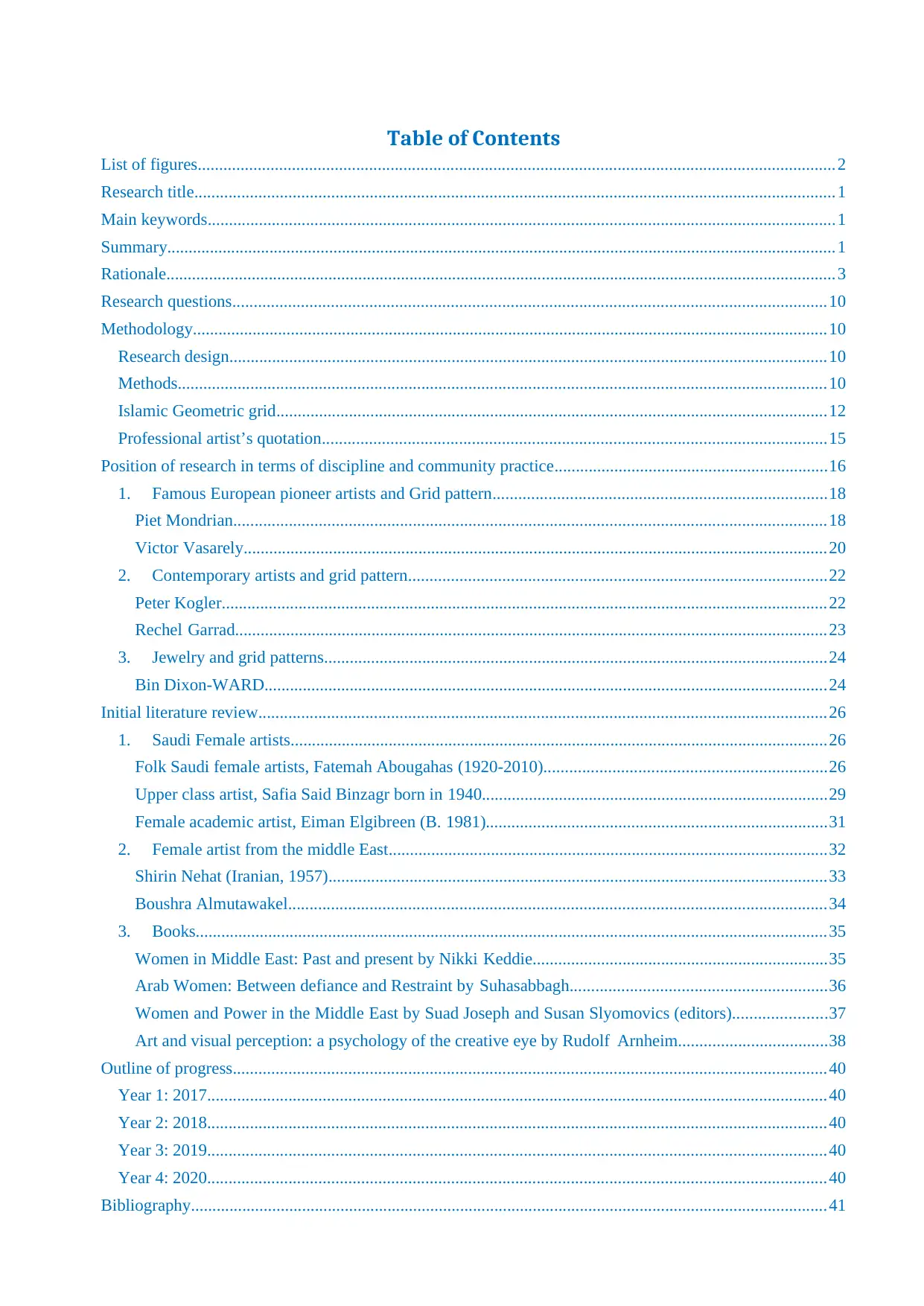
Table of Contents
List of figures.....................................................................................................................................................2
Research title......................................................................................................................................................1
Main keywords...................................................................................................................................................1
Summary.............................................................................................................................................................1
Rationale.............................................................................................................................................................3
Research questions...........................................................................................................................................10
Methodology.....................................................................................................................................................10
Research design............................................................................................................................................10
Methods........................................................................................................................................................10
Islamic Geometric grid.................................................................................................................................12
Professional artist’s quotation......................................................................................................................15
Position of research in terms of discipline and community practice................................................................16
1. Famous European pioneer artists and Grid pattern..............................................................................18
Piet Mondrian...........................................................................................................................................18
Victor Vasarely.........................................................................................................................................20
2. Contemporary artists and grid pattern..................................................................................................22
Peter Kogler..............................................................................................................................................22
Rechel Garrad...........................................................................................................................................23
3. Jewelry and grid patterns......................................................................................................................24
Bin Dixon-WARD....................................................................................................................................24
Initial literature review.....................................................................................................................................26
1. Saudi Female artists..............................................................................................................................26
Folk Saudi female artists, Fatemah Abougahas (1920-2010)..................................................................26
Upper class artist, Safia Said Binzagr born in 1940.................................................................................29
Female academic artist, Eiman Elgibreen (B. 1981)................................................................................31
2. Female artist from the middle East.......................................................................................................32
Shirin Nehat (Iranian, 1957).....................................................................................................................33
Boushra Almutawakel..............................................................................................................................34
3. Books....................................................................................................................................................35
Women in Middle East: Past and present by Nikki Keddie.....................................................................35
Arab Women: Between defiance and Restraint by Suhasabbagh............................................................36
Women and Power in the Middle East by Suad Joseph and Susan Slyomovics (editors)......................37
Art and visual perception: a psychology of the creative eye by Rudolf Arnheim...................................38
Outline of progress...........................................................................................................................................40
Year 1: 2017.................................................................................................................................................40
Year 2: 2018.................................................................................................................................................40
Year 3: 2019.................................................................................................................................................40
Year 4: 2020.................................................................................................................................................40
Bibliography.....................................................................................................................................................41
List of figures.....................................................................................................................................................2
Research title......................................................................................................................................................1
Main keywords...................................................................................................................................................1
Summary.............................................................................................................................................................1
Rationale.............................................................................................................................................................3
Research questions...........................................................................................................................................10
Methodology.....................................................................................................................................................10
Research design............................................................................................................................................10
Methods........................................................................................................................................................10
Islamic Geometric grid.................................................................................................................................12
Professional artist’s quotation......................................................................................................................15
Position of research in terms of discipline and community practice................................................................16
1. Famous European pioneer artists and Grid pattern..............................................................................18
Piet Mondrian...........................................................................................................................................18
Victor Vasarely.........................................................................................................................................20
2. Contemporary artists and grid pattern..................................................................................................22
Peter Kogler..............................................................................................................................................22
Rechel Garrad...........................................................................................................................................23
3. Jewelry and grid patterns......................................................................................................................24
Bin Dixon-WARD....................................................................................................................................24
Initial literature review.....................................................................................................................................26
1. Saudi Female artists..............................................................................................................................26
Folk Saudi female artists, Fatemah Abougahas (1920-2010)..................................................................26
Upper class artist, Safia Said Binzagr born in 1940.................................................................................29
Female academic artist, Eiman Elgibreen (B. 1981)................................................................................31
2. Female artist from the middle East.......................................................................................................32
Shirin Nehat (Iranian, 1957).....................................................................................................................33
Boushra Almutawakel..............................................................................................................................34
3. Books....................................................................................................................................................35
Women in Middle East: Past and present by Nikki Keddie.....................................................................35
Arab Women: Between defiance and Restraint by Suhasabbagh............................................................36
Women and Power in the Middle East by Suad Joseph and Susan Slyomovics (editors)......................37
Art and visual perception: a psychology of the creative eye by Rudolf Arnheim...................................38
Outline of progress...........................................................................................................................................40
Year 1: 2017.................................................................................................................................................40
Year 2: 2018.................................................................................................................................................40
Year 3: 2019.................................................................................................................................................40
Year 4: 2020.................................................................................................................................................40
Bibliography.....................................................................................................................................................41
Paraphrase This Document
Need a fresh take? Get an instant paraphrase of this document with our AI Paraphraser
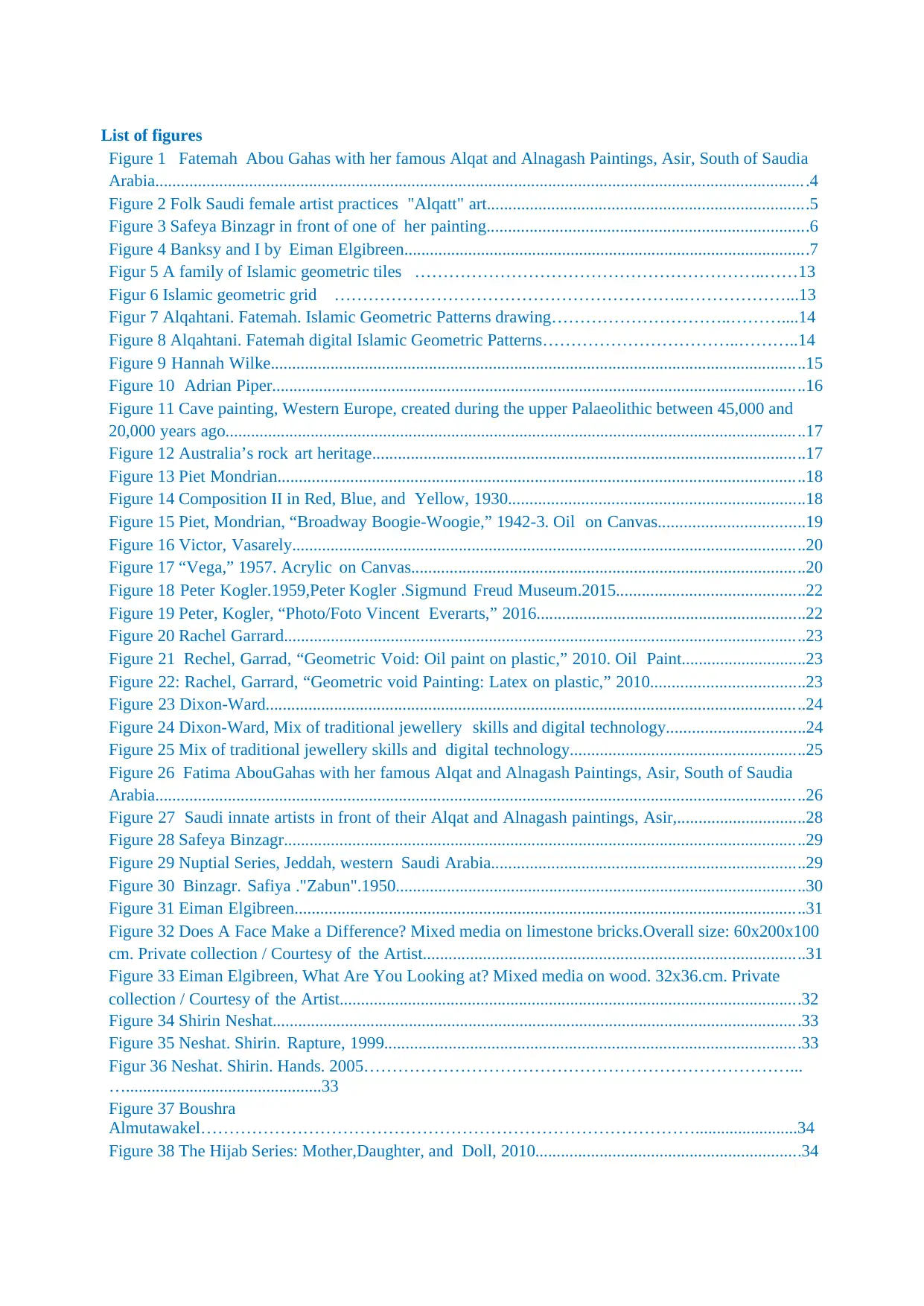
List of figures
Figure 1 Fatemah Abou Gahas with her famous Alqat and Alnagash Paintings, Asir, South of Saudia
Arabia.........................................................................................................................................................4
Figure 2 Folk Saudi female artist practices "Alqatt" art...........................................................................5
Figure 3 Safeya Binzagr in front of one of her painting...........................................................................6
Figure 4 Banksy and I by Eiman Elgibreen...............................................................................................7
Figur 5 A family of Islamic geometric tiles ……………………………………………………..……13
Figur 6 Islamic geometric grid ……………………………………………………..………………...13
Figur 7 Alqahtani. Fatemah. Islamic Geometric Patterns drawing…………………………..………....14
Figure 8 Alqahtani. Fatemah digital Islamic Geometric Patterns……………………………..………..14
Figure 9 Hannah Wilke.............................................................................................................................15
Figure 10 Adrian Piper.............................................................................................................................16
Figure 11 Cave painting, Western Europe, created during the upper Palaeolithic between 45,000 and
20,000 years ago........................................................................................................................................17
Figure 12 Australia’s rock art heritage.....................................................................................................17
Figure 13 Piet Mondrian...........................................................................................................................18
Figure 14 Composition II in Red, Blue, and Yellow, 1930.....................................................................18
Figure 15 Piet, Mondrian, “Broadway Boogie-Woogie,” 1942-3. Oil on Canvas..................................19
Figure 16 Victor, Vasarely........................................................................................................................20
Figure 17 “Vega,” 1957. Acrylic on Canvas............................................................................................20
Figure 18 Peter Kogler.1959,Peter Kogler .Sigmund Freud Museum.2015............................................22
Figure 19 Peter, Kogler, “Photo/Foto Vincent Everarts,” 2016...............................................................22
Figure 20 Rachel Garrard..........................................................................................................................23
Figure 21 Rechel, Garrad, “Geometric Void: Oil paint on plastic,” 2010. Oil Paint.............................23
Figure 22: Rachel, Garrard, “Geometric void Painting: Latex on plastic,” 2010....................................23
Figure 23 Dixon-Ward..............................................................................................................................24
Figure 24 Dixon-Ward, Mix of traditional jewellery skills and digital technology................................24
Figure 25 Mix of traditional jewellery skills and digital technology.......................................................25
Figure 26 Fatima AbouGahas with her famous Alqat and Alnagash Paintings, Asir, South of Saudia
Arabia........................................................................................................................................................26
Figure 27 Saudi innate artists in front of their Alqat and Alnagash paintings, Asir,..............................28
Figure 28 Safeya Binzagr..........................................................................................................................29
Figure 29 Nuptial Series, Jeddah, western Saudi Arabia.........................................................................29
Figure 30 Binzagr. Safiya ."Zabun".1950................................................................................................30
Figure 31 Eiman Elgibreen.......................................................................................................................31
Figure 32 Does A Face Make a Difference? Mixed media on limestone bricks.Overall size: 60x200x100
cm. Private collection / Courtesy of the Artist.........................................................................................31
Figure 33 Eiman Elgibreen, What Are You Looking at? Mixed media on wood. 32x36.cm. Private
collection / Courtesy of the Artist............................................................................................................32
Figure 34 Shirin Neshat............................................................................................................................33
Figure 35 Neshat. Shirin. Rapture, 1999.................................................................................................33
Figur 36 Neshat. Shirin. Hands. 2005…………………………………………………………………...
…..............................................33
Figure 37 Boushra
Almutawakel……………………………………………………………………………........................34
Figure 38 The Hijab Series: Mother,Daughter, and Doll, 2010..............................................................34
Figure 1 Fatemah Abou Gahas with her famous Alqat and Alnagash Paintings, Asir, South of Saudia
Arabia.........................................................................................................................................................4
Figure 2 Folk Saudi female artist practices "Alqatt" art...........................................................................5
Figure 3 Safeya Binzagr in front of one of her painting...........................................................................6
Figure 4 Banksy and I by Eiman Elgibreen...............................................................................................7
Figur 5 A family of Islamic geometric tiles ……………………………………………………..……13
Figur 6 Islamic geometric grid ……………………………………………………..………………...13
Figur 7 Alqahtani. Fatemah. Islamic Geometric Patterns drawing…………………………..………....14
Figure 8 Alqahtani. Fatemah digital Islamic Geometric Patterns……………………………..………..14
Figure 9 Hannah Wilke.............................................................................................................................15
Figure 10 Adrian Piper.............................................................................................................................16
Figure 11 Cave painting, Western Europe, created during the upper Palaeolithic between 45,000 and
20,000 years ago........................................................................................................................................17
Figure 12 Australia’s rock art heritage.....................................................................................................17
Figure 13 Piet Mondrian...........................................................................................................................18
Figure 14 Composition II in Red, Blue, and Yellow, 1930.....................................................................18
Figure 15 Piet, Mondrian, “Broadway Boogie-Woogie,” 1942-3. Oil on Canvas..................................19
Figure 16 Victor, Vasarely........................................................................................................................20
Figure 17 “Vega,” 1957. Acrylic on Canvas............................................................................................20
Figure 18 Peter Kogler.1959,Peter Kogler .Sigmund Freud Museum.2015............................................22
Figure 19 Peter, Kogler, “Photo/Foto Vincent Everarts,” 2016...............................................................22
Figure 20 Rachel Garrard..........................................................................................................................23
Figure 21 Rechel, Garrad, “Geometric Void: Oil paint on plastic,” 2010. Oil Paint.............................23
Figure 22: Rachel, Garrard, “Geometric void Painting: Latex on plastic,” 2010....................................23
Figure 23 Dixon-Ward..............................................................................................................................24
Figure 24 Dixon-Ward, Mix of traditional jewellery skills and digital technology................................24
Figure 25 Mix of traditional jewellery skills and digital technology.......................................................25
Figure 26 Fatima AbouGahas with her famous Alqat and Alnagash Paintings, Asir, South of Saudia
Arabia........................................................................................................................................................26
Figure 27 Saudi innate artists in front of their Alqat and Alnagash paintings, Asir,..............................28
Figure 28 Safeya Binzagr..........................................................................................................................29
Figure 29 Nuptial Series, Jeddah, western Saudi Arabia.........................................................................29
Figure 30 Binzagr. Safiya ."Zabun".1950................................................................................................30
Figure 31 Eiman Elgibreen.......................................................................................................................31
Figure 32 Does A Face Make a Difference? Mixed media on limestone bricks.Overall size: 60x200x100
cm. Private collection / Courtesy of the Artist.........................................................................................31
Figure 33 Eiman Elgibreen, What Are You Looking at? Mixed media on wood. 32x36.cm. Private
collection / Courtesy of the Artist............................................................................................................32
Figure 34 Shirin Neshat............................................................................................................................33
Figure 35 Neshat. Shirin. Rapture, 1999.................................................................................................33
Figur 36 Neshat. Shirin. Hands. 2005…………………………………………………………………...
…..............................................33
Figure 37 Boushra
Almutawakel……………………………………………………………………………........................34
Figure 38 The Hijab Series: Mother,Daughter, and Doll, 2010..............................................................34
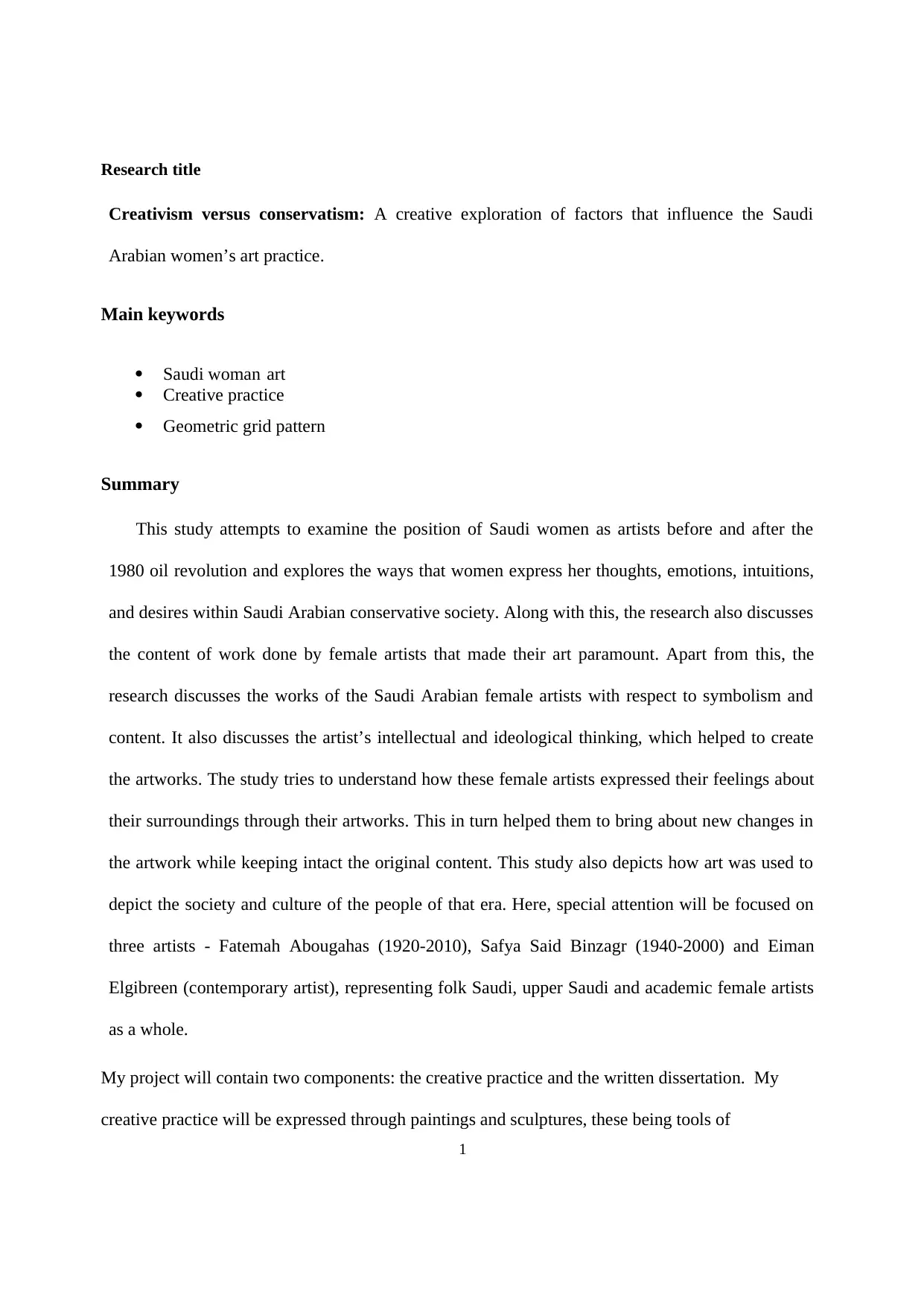
Research title
Creativism versus conservatism: A creative exploration of factors that influence the Saudi
Arabian women’s art practice.
Main keywords
Saudi woman art
Creative practice
Geometric grid pattern
Summary
This study attempts to examine the position of Saudi women as artists before and after the
1980 oil revolution and explores the ways that women express her thoughts, emotions, intuitions,
and desires within Saudi Arabian conservative society. Along with this, the research also discusses
the content of work done by female artists that made their art paramount. Apart from this, the
research discusses the works of the Saudi Arabian female artists with respect to symbolism and
content. It also discusses the artist’s intellectual and ideological thinking, which helped to create
the artworks. The study tries to understand how these female artists expressed their feelings about
their surroundings through their artworks. This in turn helped them to bring about new changes in
the artwork while keeping intact the original content. This study also depicts how art was used to
depict the society and culture of the people of that era. Here, special attention will be focused on
three artists - Fatemah Abougahas (1920-2010), Safya Said Binzagr (1940-2000) and Eiman
Elgibreen (contemporary artist), representing folk Saudi, upper Saudi and academic female artists
as a whole.
My project will contain two components: the creative practice and the written dissertation. My
creative practice will be expressed through paintings and sculptures, these being tools of
1
Creativism versus conservatism: A creative exploration of factors that influence the Saudi
Arabian women’s art practice.
Main keywords
Saudi woman art
Creative practice
Geometric grid pattern
Summary
This study attempts to examine the position of Saudi women as artists before and after the
1980 oil revolution and explores the ways that women express her thoughts, emotions, intuitions,
and desires within Saudi Arabian conservative society. Along with this, the research also discusses
the content of work done by female artists that made their art paramount. Apart from this, the
research discusses the works of the Saudi Arabian female artists with respect to symbolism and
content. It also discusses the artist’s intellectual and ideological thinking, which helped to create
the artworks. The study tries to understand how these female artists expressed their feelings about
their surroundings through their artworks. This in turn helped them to bring about new changes in
the artwork while keeping intact the original content. This study also depicts how art was used to
depict the society and culture of the people of that era. Here, special attention will be focused on
three artists - Fatemah Abougahas (1920-2010), Safya Said Binzagr (1940-2000) and Eiman
Elgibreen (contemporary artist), representing folk Saudi, upper Saudi and academic female artists
as a whole.
My project will contain two components: the creative practice and the written dissertation. My
creative practice will be expressed through paintings and sculptures, these being tools of
1
⊘ This is a preview!⊘
Do you want full access?
Subscribe today to unlock all pages.

Trusted by 1+ million students worldwide
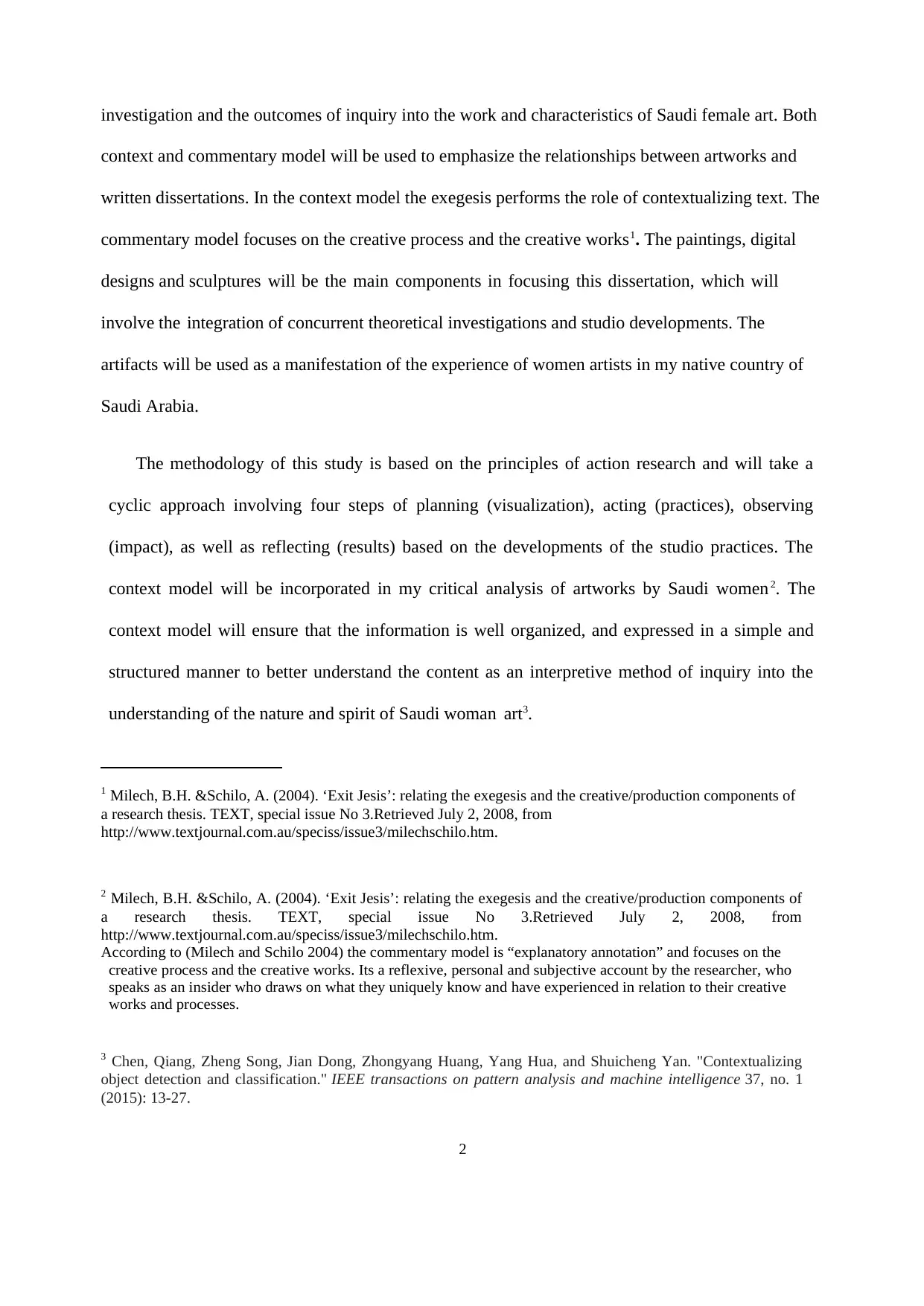
investigation and the outcomes of inquiry into the work and characteristics of Saudi female art. Both
context and commentary model will be used to emphasize the relationships between artworks and
written dissertations. In the context model the exegesis performs the role of contextualizing text. The
commentary model focuses on the creative process and the creative works1. The paintings, digital
designs and sculptures will be the main components in focusing this dissertation, which will
involve the integration of concurrent theoretical investigations and studio developments. The
artifacts will be used as a manifestation of the experience of women artists in my native country of
Saudi Arabia.
The methodology of this study is based on the principles of action research and will take a
cyclic approach involving four steps of planning (visualization), acting (practices), observing
(impact), as well as reflecting (results) based on the developments of the studio practices. The
context model will be incorporated in my critical analysis of artworks by Saudi women2. The
context model will ensure that the information is well organized, and expressed in a simple and
structured manner to better understand the content as an interpretive method of inquiry into the
understanding of the nature and spirit of Saudi woman art3.
1 Milech, B.H. &Schilo, A. (2004). ‘Exit Jesis’: relating the exegesis and the creative/production components of
a research thesis. TEXT, special issue No 3.Retrieved July 2, 2008, from
http://www.textjournal.com.au/speciss/issue3/milechschilo.htm.
2 Milech, B.H. &Schilo, A. (2004). ‘Exit Jesis’: relating the exegesis and the creative/production components of
a research thesis. TEXT, special issue No 3.Retrieved July 2, 2008, from
http://www.textjournal.com.au/speciss/issue3/milechschilo.htm.
According to (Milech and Schilo 2004) the commentary model is “explanatory annotation” and focuses on the
creative process and the creative works. Its a reflexive, personal and subjective account by the researcher, who
speaks as an insider who draws on what they uniquely know and have experienced in relation to their creative
works and processes.
3 Chen, Qiang, Zheng Song, Jian Dong, Zhongyang Huang, Yang Hua, and Shuicheng Yan. "Contextualizing
object detection and classification." IEEE transactions on pattern analysis and machine intelligence 37, no. 1
(2015): 13-27.
2
context and commentary model will be used to emphasize the relationships between artworks and
written dissertations. In the context model the exegesis performs the role of contextualizing text. The
commentary model focuses on the creative process and the creative works1. The paintings, digital
designs and sculptures will be the main components in focusing this dissertation, which will
involve the integration of concurrent theoretical investigations and studio developments. The
artifacts will be used as a manifestation of the experience of women artists in my native country of
Saudi Arabia.
The methodology of this study is based on the principles of action research and will take a
cyclic approach involving four steps of planning (visualization), acting (practices), observing
(impact), as well as reflecting (results) based on the developments of the studio practices. The
context model will be incorporated in my critical analysis of artworks by Saudi women2. The
context model will ensure that the information is well organized, and expressed in a simple and
structured manner to better understand the content as an interpretive method of inquiry into the
understanding of the nature and spirit of Saudi woman art3.
1 Milech, B.H. &Schilo, A. (2004). ‘Exit Jesis’: relating the exegesis and the creative/production components of
a research thesis. TEXT, special issue No 3.Retrieved July 2, 2008, from
http://www.textjournal.com.au/speciss/issue3/milechschilo.htm.
2 Milech, B.H. &Schilo, A. (2004). ‘Exit Jesis’: relating the exegesis and the creative/production components of
a research thesis. TEXT, special issue No 3.Retrieved July 2, 2008, from
http://www.textjournal.com.au/speciss/issue3/milechschilo.htm.
According to (Milech and Schilo 2004) the commentary model is “explanatory annotation” and focuses on the
creative process and the creative works. Its a reflexive, personal and subjective account by the researcher, who
speaks as an insider who draws on what they uniquely know and have experienced in relation to their creative
works and processes.
3 Chen, Qiang, Zheng Song, Jian Dong, Zhongyang Huang, Yang Hua, and Shuicheng Yan. "Contextualizing
object detection and classification." IEEE transactions on pattern analysis and machine intelligence 37, no. 1
(2015): 13-27.
2
Paraphrase This Document
Need a fresh take? Get an instant paraphrase of this document with our AI Paraphraser
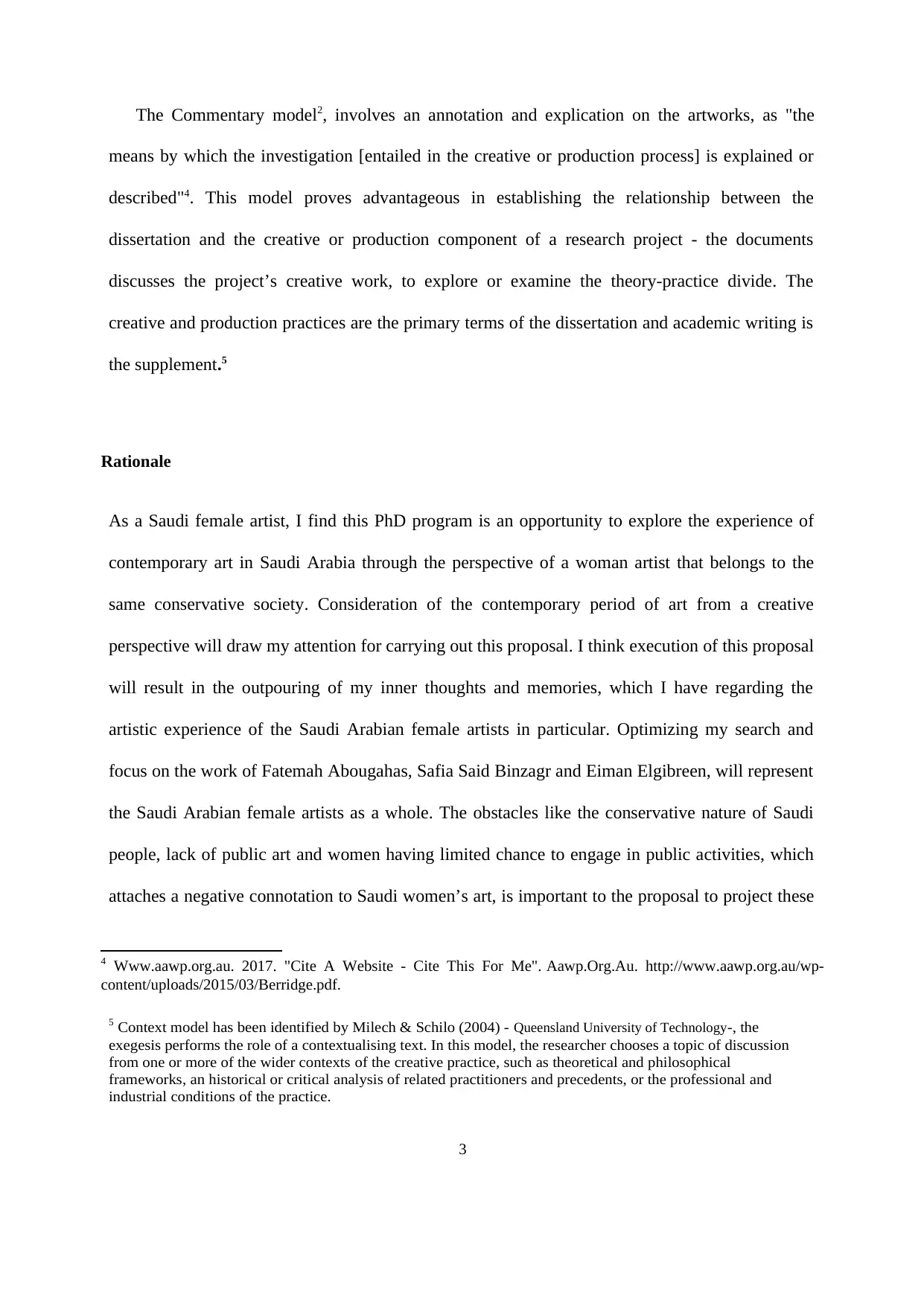
The Commentary model2, involves an annotation and explication on the artworks, as "the
means by which the investigation [entailed in the creative or production process] is explained or
described"4. This model proves advantageous in establishing the relationship between the
dissertation and the creative or production component of a research project - the documents
discusses the project’s creative work, to explore or examine the theory-practice divide. The
creative and production practices are the primary terms of the dissertation and academic writing is
the supplement.5
Rationale
As a Saudi female artist, I find this PhD program is an opportunity to explore the experience of
contemporary art in Saudi Arabia through the perspective of a woman artist that belongs to the
same conservative society. Consideration of the contemporary period of art from a creative
perspective will draw my attention for carrying out this proposal. I think execution of this proposal
will result in the outpouring of my inner thoughts and memories, which I have regarding the
artistic experience of the Saudi Arabian female artists in particular. Optimizing my search and
focus on the work of Fatemah Abougahas, Safia Said Binzagr and Eiman Elgibreen, will represent
the Saudi Arabian female artists as a whole. The obstacles like the conservative nature of Saudi
people, lack of public art and women having limited chance to engage in public activities, which
attaches a negative connotation to Saudi women’s art, is important to the proposal to project these
4 Www.aawp.org.au. 2017. "Cite A Website - Cite This For Me". Aawp.Org.Au. http://www.aawp.org.au/wp-
content/uploads/2015/03/Berridge.pdf.
5 Context model has been identified by Milech & Schilo (2004) - Queensland University of Technology -, the
exegesis performs the role of a contextualising text. In this model, the researcher chooses a topic of discussion
from one or more of the wider contexts of the creative practice, such as theoretical and philosophical
frameworks, an historical or critical analysis of related practitioners and precedents, or the professional and
industrial conditions of the practice.
3
means by which the investigation [entailed in the creative or production process] is explained or
described"4. This model proves advantageous in establishing the relationship between the
dissertation and the creative or production component of a research project - the documents
discusses the project’s creative work, to explore or examine the theory-practice divide. The
creative and production practices are the primary terms of the dissertation and academic writing is
the supplement.5
Rationale
As a Saudi female artist, I find this PhD program is an opportunity to explore the experience of
contemporary art in Saudi Arabia through the perspective of a woman artist that belongs to the
same conservative society. Consideration of the contemporary period of art from a creative
perspective will draw my attention for carrying out this proposal. I think execution of this proposal
will result in the outpouring of my inner thoughts and memories, which I have regarding the
artistic experience of the Saudi Arabian female artists in particular. Optimizing my search and
focus on the work of Fatemah Abougahas, Safia Said Binzagr and Eiman Elgibreen, will represent
the Saudi Arabian female artists as a whole. The obstacles like the conservative nature of Saudi
people, lack of public art and women having limited chance to engage in public activities, which
attaches a negative connotation to Saudi women’s art, is important to the proposal to project these
4 Www.aawp.org.au. 2017. "Cite A Website - Cite This For Me". Aawp.Org.Au. http://www.aawp.org.au/wp-
content/uploads/2015/03/Berridge.pdf.
5 Context model has been identified by Milech & Schilo (2004) - Queensland University of Technology -, the
exegesis performs the role of a contextualising text. In this model, the researcher chooses a topic of discussion
from one or more of the wider contexts of the creative practice, such as theoretical and philosophical
frameworks, an historical or critical analysis of related practitioners and precedents, or the professional and
industrial conditions of the practice.
3
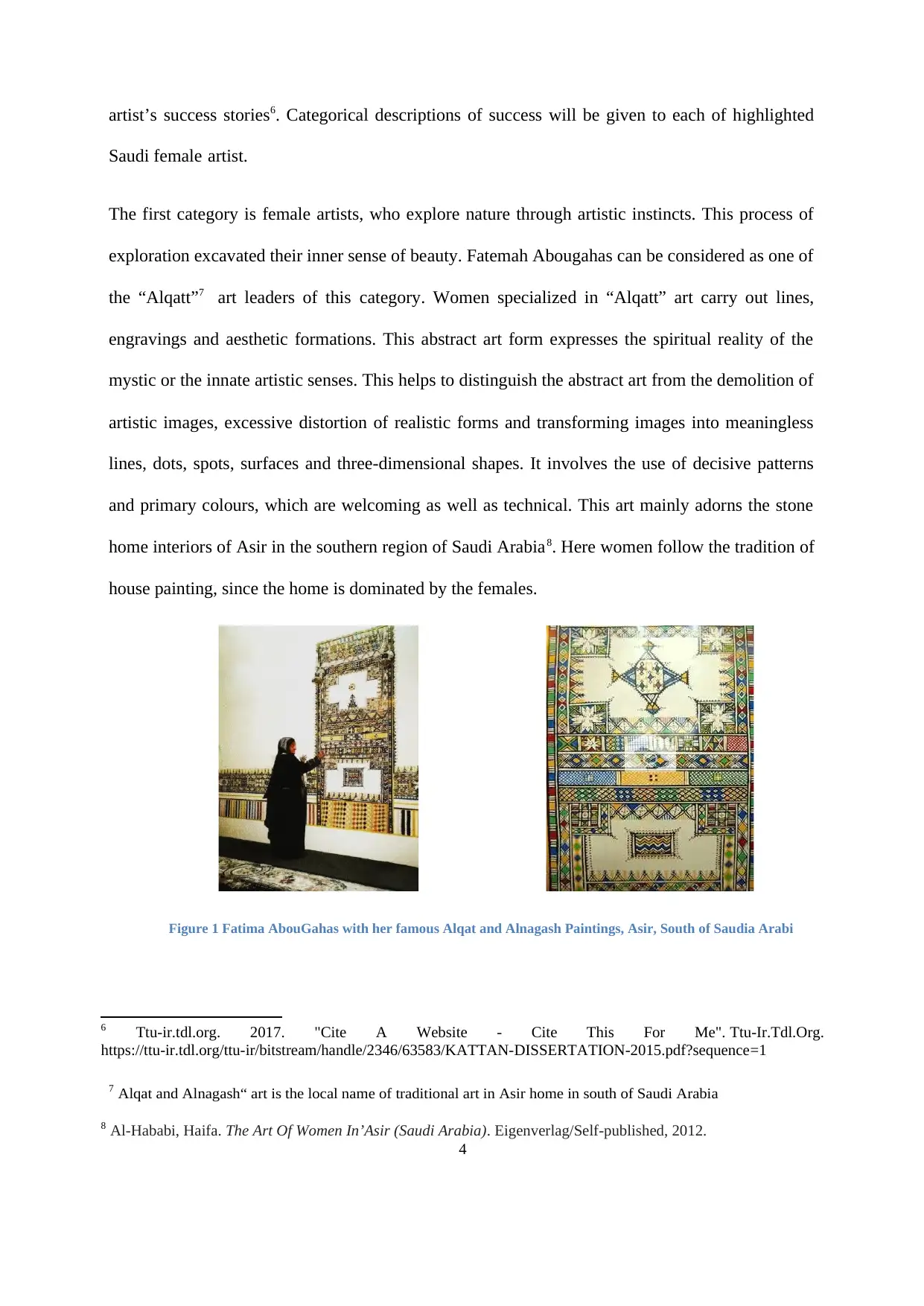
artist’s success stories6. Categorical descriptions of success will be given to each of highlighted
Saudi female artist.
The first category is female artists, who explore nature through artistic instincts. This process of
exploration excavated their inner sense of beauty. Fatemah Abougahas can be considered as one of
the “Alqatt”7 art leaders of this category. Women specialized in “Alqatt” art carry out lines,
engravings and aesthetic formations. This abstract art form expresses the spiritual reality of the
mystic or the innate artistic senses. This helps to distinguish the abstract art from the demolition of
artistic images, excessive distortion of realistic forms and transforming images into meaningless
lines, dots, spots, surfaces and three-dimensional shapes. It involves the use of decisive patterns
and primary colours, which are welcoming as well as technical. This art mainly adorns the stone
home interiors of Asir in the southern region of Saudi Arabia8. Here women follow the tradition of
house painting, since the home is dominated by the females.
6 Ttu-ir.tdl.org. 2017. "Cite A Website - Cite This For Me". Ttu-Ir.Tdl.Org.
https://ttu-ir.tdl.org/ttu-ir/bitstream/handle/2346/63583/KATTAN-DISSERTATION-2015.pdf?sequence=1
7 Alqat and Alnagash“ art is the local name of traditional art in Asir home in south of Saudi Arabia
8 Al-Hababi, Haifa. The Art Of Women In’Asir (Saudi Arabia). Eigenverlag/Self-published, 2012.
4
Figure 1 Fatima AbouGahas with her famous Alqat and Alnagash Paintings, Asir, South of Saudia Arabi
Saudi female artist.
The first category is female artists, who explore nature through artistic instincts. This process of
exploration excavated their inner sense of beauty. Fatemah Abougahas can be considered as one of
the “Alqatt”7 art leaders of this category. Women specialized in “Alqatt” art carry out lines,
engravings and aesthetic formations. This abstract art form expresses the spiritual reality of the
mystic or the innate artistic senses. This helps to distinguish the abstract art from the demolition of
artistic images, excessive distortion of realistic forms and transforming images into meaningless
lines, dots, spots, surfaces and three-dimensional shapes. It involves the use of decisive patterns
and primary colours, which are welcoming as well as technical. This art mainly adorns the stone
home interiors of Asir in the southern region of Saudi Arabia8. Here women follow the tradition of
house painting, since the home is dominated by the females.
6 Ttu-ir.tdl.org. 2017. "Cite A Website - Cite This For Me". Ttu-Ir.Tdl.Org.
https://ttu-ir.tdl.org/ttu-ir/bitstream/handle/2346/63583/KATTAN-DISSERTATION-2015.pdf?sequence=1
7 Alqat and Alnagash“ art is the local name of traditional art in Asir home in south of Saudi Arabia
8 Al-Hababi, Haifa. The Art Of Women In’Asir (Saudi Arabia). Eigenverlag/Self-published, 2012.
4
Figure 1 Fatima AbouGahas with her famous Alqat and Alnagash Paintings, Asir, South of Saudia Arabi
⊘ This is a preview!⊘
Do you want full access?
Subscribe today to unlock all pages.

Trusted by 1+ million students worldwide
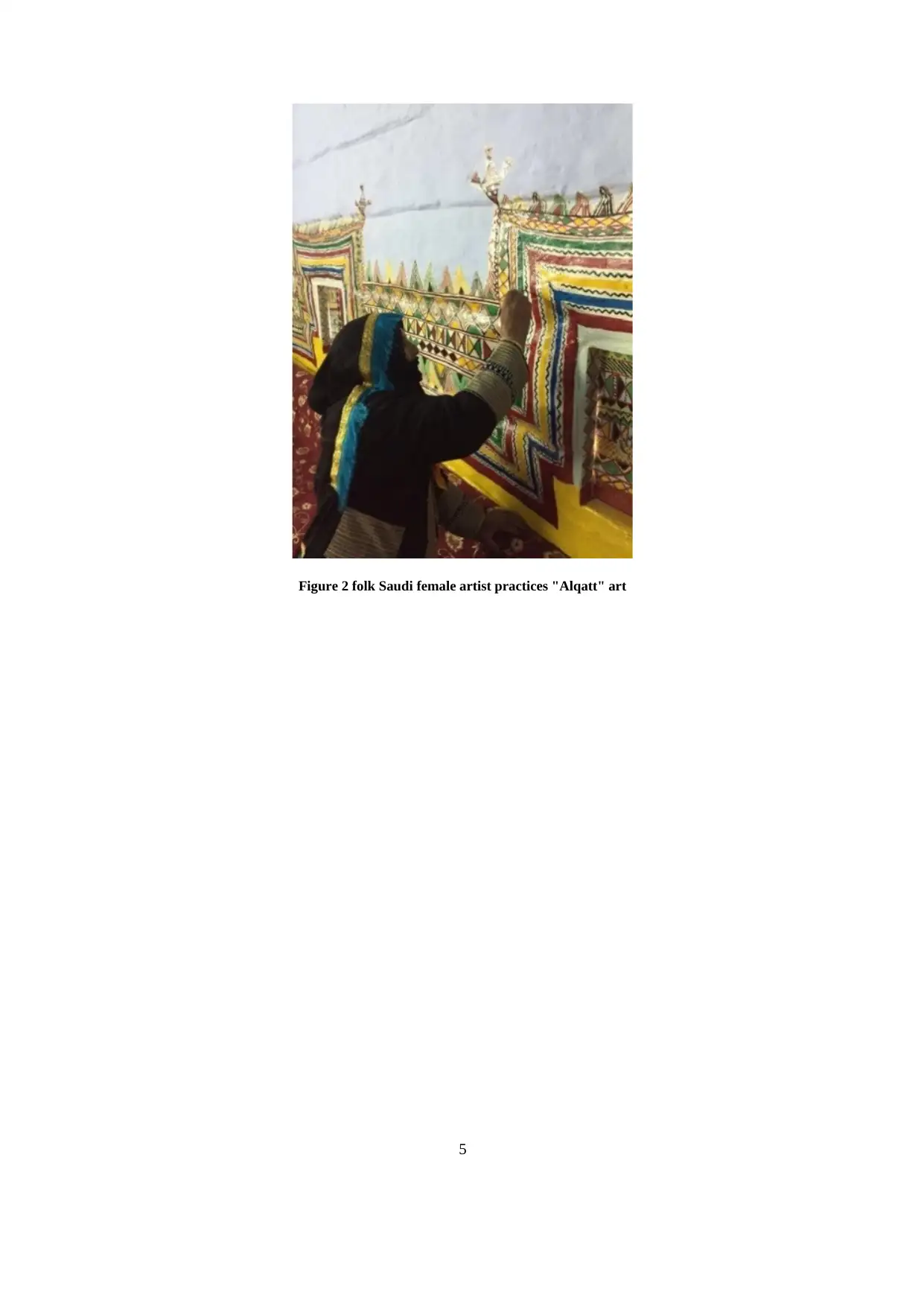
Figure 2 folk Saudi female artist practices "Alqatt" art
5
5
Paraphrase This Document
Need a fresh take? Get an instant paraphrase of this document with our AI Paraphraser
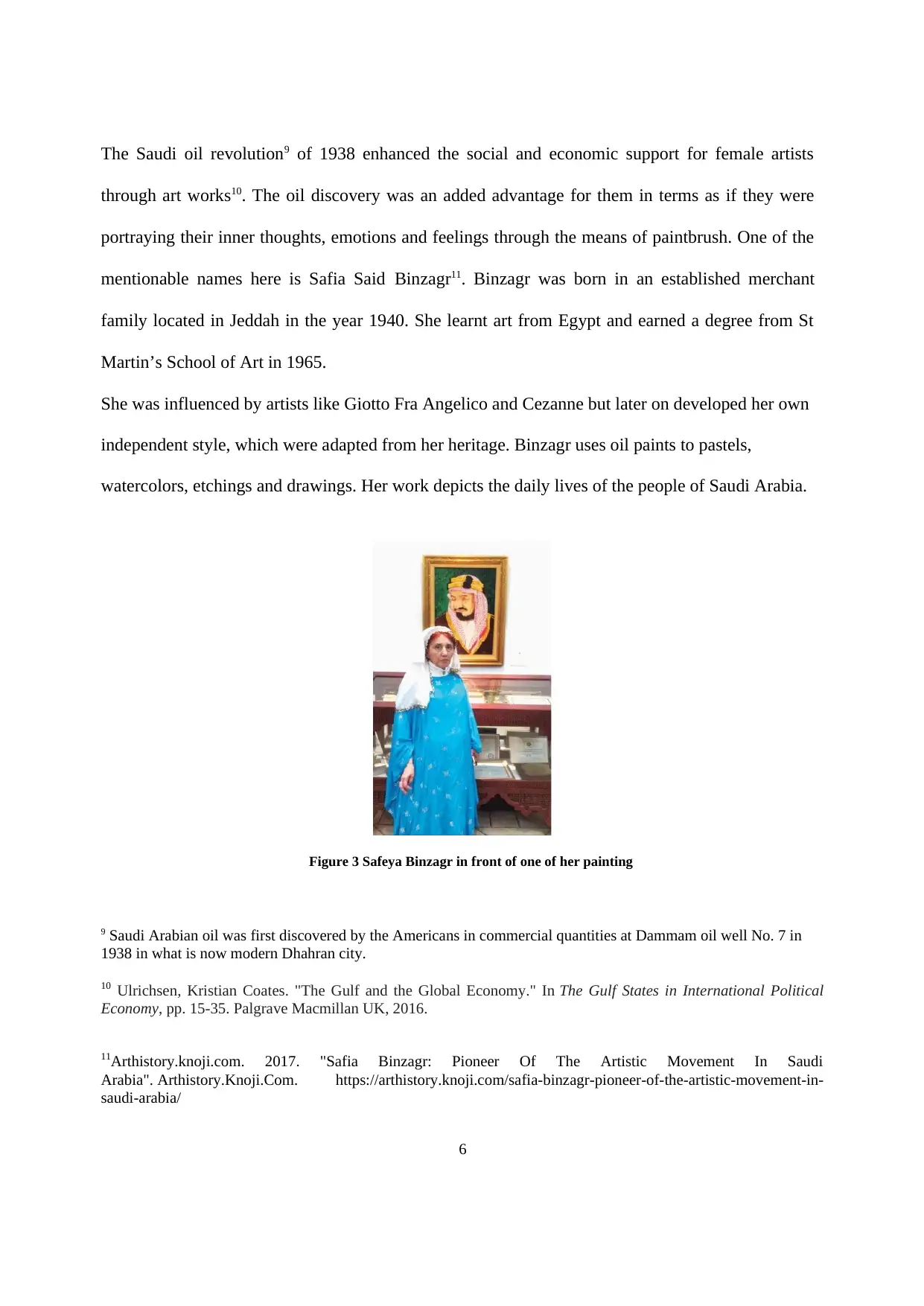
The Saudi oil revolution9 of 1938 enhanced the social and economic support for female artists
through art works10. The oil discovery was an added advantage for them in terms as if they were
portraying their inner thoughts, emotions and feelings through the means of paintbrush. One of the
mentionable names here is Safia Said Binzagr11. Binzagr was born in an established merchant
family located in Jeddah in the year 1940. She learnt art from Egypt and earned a degree from St
Martin’s School of Art in 1965.
She was influenced by artists like Giotto Fra Angelico and Cezanne but later on developed her own
independent style, which were adapted from her heritage. Binzagr uses oil paints to pastels,
watercolors, etchings and drawings. Her work depicts the daily lives of the people of Saudi Arabia.
9 Saudi Arabian oil was first discovered by the Americans in commercial quantities at Dammam oil well No. 7 in
1938 in what is now modern Dhahran city.
10 Ulrichsen, Kristian Coates. "The Gulf and the Global Economy." In The Gulf States in International Political
Economy, pp. 15-35. Palgrave Macmillan UK, 2016.
11Arthistory.knoji.com. 2017. "Safia Binzagr: Pioneer Of The Artistic Movement In Saudi
Arabia". Arthistory.Knoji.Com. https://arthistory.knoji.com/safia-binzagr-pioneer-of-the-artistic-movement-in-
saudi-arabia/
6
Figure 3 Safeya Binzagr in front of one of her painting
through art works10. The oil discovery was an added advantage for them in terms as if they were
portraying their inner thoughts, emotions and feelings through the means of paintbrush. One of the
mentionable names here is Safia Said Binzagr11. Binzagr was born in an established merchant
family located in Jeddah in the year 1940. She learnt art from Egypt and earned a degree from St
Martin’s School of Art in 1965.
She was influenced by artists like Giotto Fra Angelico and Cezanne but later on developed her own
independent style, which were adapted from her heritage. Binzagr uses oil paints to pastels,
watercolors, etchings and drawings. Her work depicts the daily lives of the people of Saudi Arabia.
9 Saudi Arabian oil was first discovered by the Americans in commercial quantities at Dammam oil well No. 7 in
1938 in what is now modern Dhahran city.
10 Ulrichsen, Kristian Coates. "The Gulf and the Global Economy." In The Gulf States in International Political
Economy, pp. 15-35. Palgrave Macmillan UK, 2016.
11Arthistory.knoji.com. 2017. "Safia Binzagr: Pioneer Of The Artistic Movement In Saudi
Arabia". Arthistory.Knoji.Com. https://arthistory.knoji.com/safia-binzagr-pioneer-of-the-artistic-movement-in-
saudi-arabia/
6
Figure 3 Safeya Binzagr in front of one of her painting
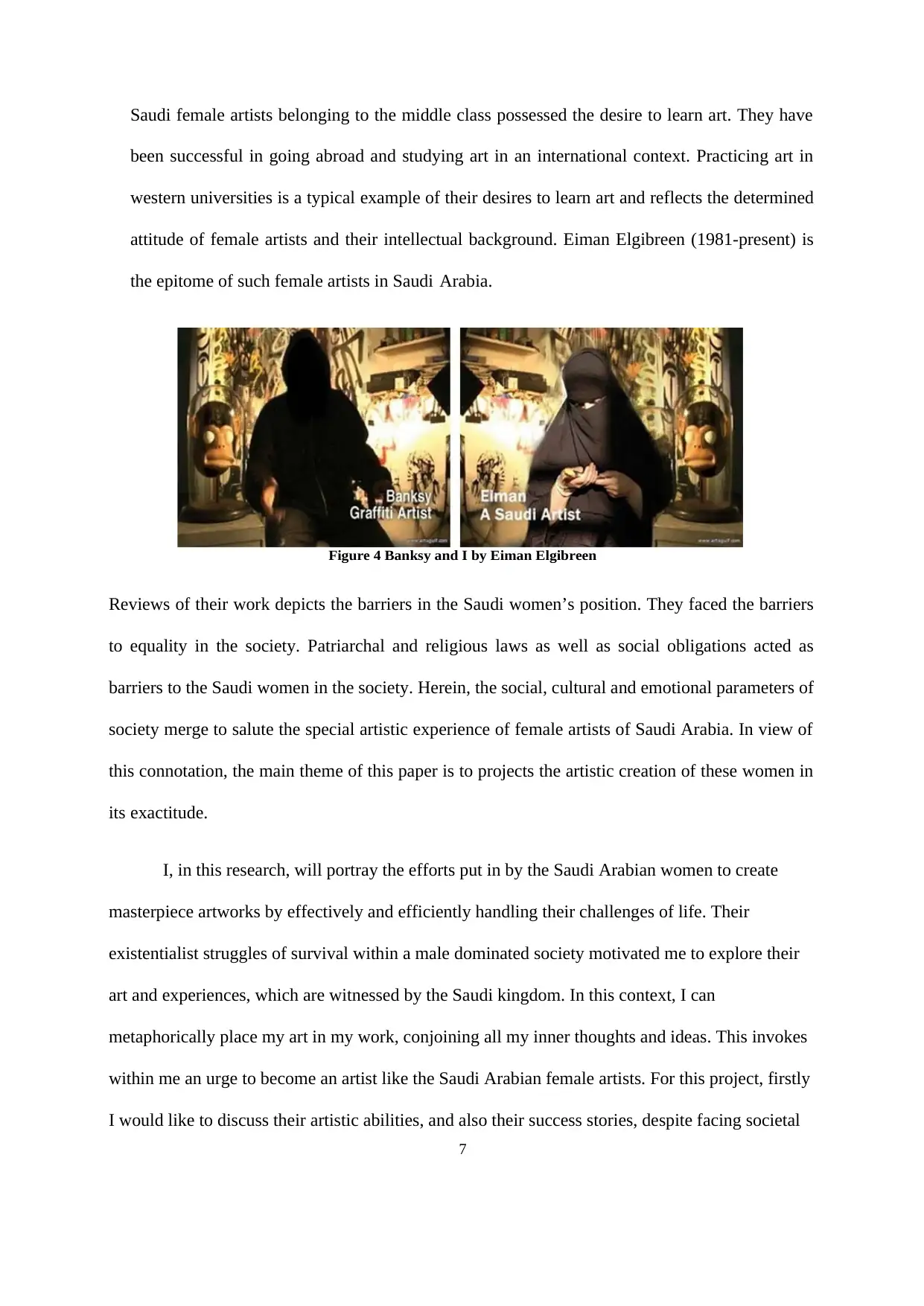
Saudi female artists belonging to the middle class possessed the desire to learn art. They have
been successful in going abroad and studying art in an international context. Practicing art in
western universities is a typical example of their desires to learn art and reflects the determined
attitude of female artists and their intellectual background. Eiman Elgibreen (1981-present) is
the epitome of such female artists in Saudi Arabia.
Figure 4 Banksy and I by Eiman Elgibreen
Reviews of their work depicts the barriers in the Saudi women’s position. They faced the barriers
to equality in the society. Patriarchal and religious laws as well as social obligations acted as
barriers to the Saudi women in the society. Herein, the social, cultural and emotional parameters of
society merge to salute the special artistic experience of female artists of Saudi Arabia. In view of
this connotation, the main theme of this paper is to projects the artistic creation of these women in
its exactitude.
I, in this research, will portray the efforts put in by the Saudi Arabian women to create
masterpiece artworks by effectively and efficiently handling their challenges of life. Their
existentialist struggles of survival within a male dominated society motivated me to explore their
art and experiences, which are witnessed by the Saudi kingdom. In this context, I can
metaphorically place my art in my work, conjoining all my inner thoughts and ideas. This invokes
within me an urge to become an artist like the Saudi Arabian female artists. For this project, firstly
I would like to discuss their artistic abilities, and also their success stories, despite facing societal
7
been successful in going abroad and studying art in an international context. Practicing art in
western universities is a typical example of their desires to learn art and reflects the determined
attitude of female artists and their intellectual background. Eiman Elgibreen (1981-present) is
the epitome of such female artists in Saudi Arabia.
Figure 4 Banksy and I by Eiman Elgibreen
Reviews of their work depicts the barriers in the Saudi women’s position. They faced the barriers
to equality in the society. Patriarchal and religious laws as well as social obligations acted as
barriers to the Saudi women in the society. Herein, the social, cultural and emotional parameters of
society merge to salute the special artistic experience of female artists of Saudi Arabia. In view of
this connotation, the main theme of this paper is to projects the artistic creation of these women in
its exactitude.
I, in this research, will portray the efforts put in by the Saudi Arabian women to create
masterpiece artworks by effectively and efficiently handling their challenges of life. Their
existentialist struggles of survival within a male dominated society motivated me to explore their
art and experiences, which are witnessed by the Saudi kingdom. In this context, I can
metaphorically place my art in my work, conjoining all my inner thoughts and ideas. This invokes
within me an urge to become an artist like the Saudi Arabian female artists. For this project, firstly
I would like to discuss their artistic abilities, and also their success stories, despite facing societal
7
⊘ This is a preview!⊘
Do you want full access?
Subscribe today to unlock all pages.

Trusted by 1+ million students worldwide

and religious challenges in the Saudi Arabian community.
8
8
Paraphrase This Document
Need a fresh take? Get an instant paraphrase of this document with our AI Paraphraser
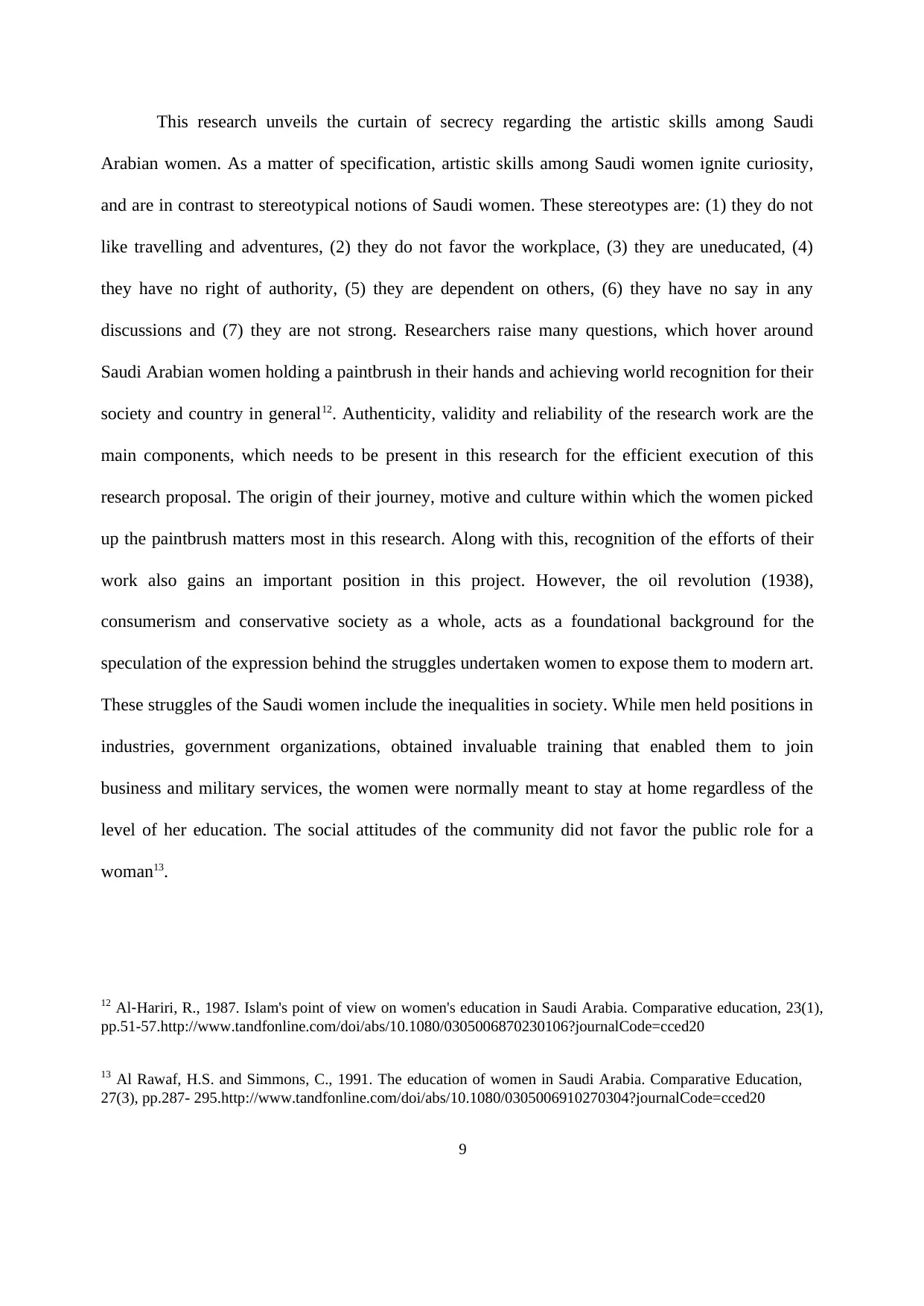
This research unveils the curtain of secrecy regarding the artistic skills among Saudi
Arabian women. As a matter of specification, artistic skills among Saudi women ignite curiosity,
and are in contrast to stereotypical notions of Saudi women. These stereotypes are: (1) they do not
like travelling and adventures, (2) they do not favor the workplace, (3) they are uneducated, (4)
they have no right of authority, (5) they are dependent on others, (6) they have no say in any
discussions and (7) they are not strong. Researchers raise many questions, which hover around
Saudi Arabian women holding a paintbrush in their hands and achieving world recognition for their
society and country in general12. Authenticity, validity and reliability of the research work are the
main components, which needs to be present in this research for the efficient execution of this
research proposal. The origin of their journey, motive and culture within which the women picked
up the paintbrush matters most in this research. Along with this, recognition of the efforts of their
work also gains an important position in this project. However, the oil revolution (1938),
consumerism and conservative society as a whole, acts as a foundational background for the
speculation of the expression behind the struggles undertaken women to expose them to modern art.
These struggles of the Saudi women include the inequalities in society. While men held positions in
industries, government organizations, obtained invaluable training that enabled them to join
business and military services, the women were normally meant to stay at home regardless of the
level of her education. The social attitudes of the community did not favor the public role for a
woman13.
12 Al‐Hariri, R., 1987. Islam's point of view on women's education in Saudi Arabia. Comparative education, 23(1),
pp.51-57.http://www.tandfonline.com/doi/abs/10.1080/0305006870230106?journalCode=cced20
13 Al Rawaf, H.S. and Simmons, C., 1991. The education of women in Saudi Arabia. Comparative Education,
27(3), pp.287- 295.http://www.tandfonline.com/doi/abs/10.1080/0305006910270304?journalCode=cced20
9
Arabian women. As a matter of specification, artistic skills among Saudi women ignite curiosity,
and are in contrast to stereotypical notions of Saudi women. These stereotypes are: (1) they do not
like travelling and adventures, (2) they do not favor the workplace, (3) they are uneducated, (4)
they have no right of authority, (5) they are dependent on others, (6) they have no say in any
discussions and (7) they are not strong. Researchers raise many questions, which hover around
Saudi Arabian women holding a paintbrush in their hands and achieving world recognition for their
society and country in general12. Authenticity, validity and reliability of the research work are the
main components, which needs to be present in this research for the efficient execution of this
research proposal. The origin of their journey, motive and culture within which the women picked
up the paintbrush matters most in this research. Along with this, recognition of the efforts of their
work also gains an important position in this project. However, the oil revolution (1938),
consumerism and conservative society as a whole, acts as a foundational background for the
speculation of the expression behind the struggles undertaken women to expose them to modern art.
These struggles of the Saudi women include the inequalities in society. While men held positions in
industries, government organizations, obtained invaluable training that enabled them to join
business and military services, the women were normally meant to stay at home regardless of the
level of her education. The social attitudes of the community did not favor the public role for a
woman13.
12 Al‐Hariri, R., 1987. Islam's point of view on women's education in Saudi Arabia. Comparative education, 23(1),
pp.51-57.http://www.tandfonline.com/doi/abs/10.1080/0305006870230106?journalCode=cced20
13 Al Rawaf, H.S. and Simmons, C., 1991. The education of women in Saudi Arabia. Comparative Education,
27(3), pp.287- 295.http://www.tandfonline.com/doi/abs/10.1080/0305006910270304?journalCode=cced20
9
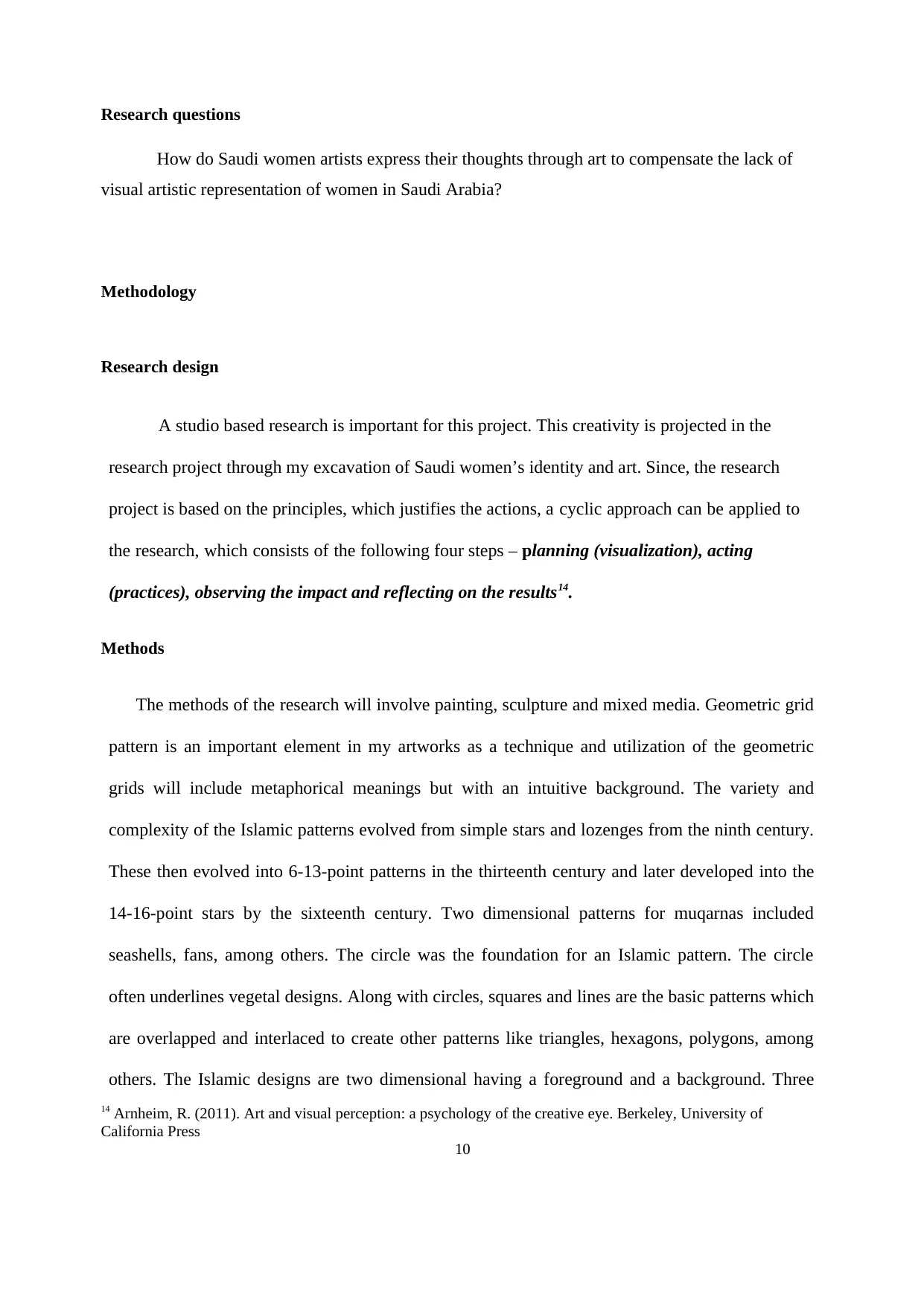
Research questions
How do Saudi women artists express their thoughts through art to compensate the lack of
visual artistic representation of women in Saudi Arabia?
Methodology
Research design
A studio based research is important for this project. This creativity is projected in the
research project through my excavation of Saudi women’s identity and art. Since, the research
project is based on the principles, which justifies the actions, a cyclic approach can be applied to
the research, which consists of the following four steps – planning (visualization), acting
(practices), observing the impact and reflecting on the results14.
Methods
The methods of the research will involve painting, sculpture and mixed media. Geometric grid
pattern is an important element in my artworks as a technique and utilization of the geometric
grids will include metaphorical meanings but with an intuitive background. The variety and
complexity of the Islamic patterns evolved from simple stars and lozenges from the ninth century.
These then evolved into 6-13-point patterns in the thirteenth century and later developed into the
14-16-point stars by the sixteenth century. Two dimensional patterns for muqarnas included
seashells, fans, among others. The circle was the foundation for an Islamic pattern. The circle
often underlines vegetal designs. Along with circles, squares and lines are the basic patterns which
are overlapped and interlaced to create other patterns like triangles, hexagons, polygons, among
others. The Islamic designs are two dimensional having a foreground and a background. Three
14 Arnheim, R. (2011). Art and visual perception: a psychology of the creative eye. Berkeley, University of
California Press
10
How do Saudi women artists express their thoughts through art to compensate the lack of
visual artistic representation of women in Saudi Arabia?
Methodology
Research design
A studio based research is important for this project. This creativity is projected in the
research project through my excavation of Saudi women’s identity and art. Since, the research
project is based on the principles, which justifies the actions, a cyclic approach can be applied to
the research, which consists of the following four steps – planning (visualization), acting
(practices), observing the impact and reflecting on the results14.
Methods
The methods of the research will involve painting, sculpture and mixed media. Geometric grid
pattern is an important element in my artworks as a technique and utilization of the geometric
grids will include metaphorical meanings but with an intuitive background. The variety and
complexity of the Islamic patterns evolved from simple stars and lozenges from the ninth century.
These then evolved into 6-13-point patterns in the thirteenth century and later developed into the
14-16-point stars by the sixteenth century. Two dimensional patterns for muqarnas included
seashells, fans, among others. The circle was the foundation for an Islamic pattern. The circle
often underlines vegetal designs. Along with circles, squares and lines are the basic patterns which
are overlapped and interlaced to create other patterns like triangles, hexagons, polygons, among
others. The Islamic designs are two dimensional having a foreground and a background. Three
14 Arnheim, R. (2011). Art and visual perception: a psychology of the creative eye. Berkeley, University of
California Press
10
⊘ This is a preview!⊘
Do you want full access?
Subscribe today to unlock all pages.

Trusted by 1+ million students worldwide
1 out of 49
Your All-in-One AI-Powered Toolkit for Academic Success.
+13062052269
info@desklib.com
Available 24*7 on WhatsApp / Email
![[object Object]](/_next/static/media/star-bottom.7253800d.svg)
Unlock your academic potential
Copyright © 2020–2025 A2Z Services. All Rights Reserved. Developed and managed by ZUCOL.

